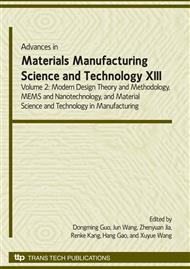p.113
p.119
p.125
p.131
p.137
p.143
p.149
p.155
p.161
Characteristics of Singular Point on Cycloid and its Application in Parallel Indexing Cam Mechanisms
Abstract:
A planar cam theoretical profile can be considered as cycloid of the roller center. There is singular point on the cycloid when the roller center is located on the instantaneous axis. Then, the curvature of the cycloid at the singular point is likely to be infinite and interference may be inevitable. Thus, avoiding such singular point is imperative in cam profile design. But, in analyzing the characteristics of the tangent vector and curvature at such singular point, it reveals that the curvature may be finite, even zero, if the cycloid fulfills some condition at the singular point. This leads to a very important property that at the singular point the tangent of the cycloid is parallel to the normal of the instantaneous center curve. The pressure angle is very small even zero. These results would be very efficacious in planar cam mechanism applications. The characteristics of singular point on cycloid are detailed in this paper. As application, a novel kind of parallel indexing cam mechanism is developed. Its configuration and principle are described.
Info:
Periodical:
Pages:
137-142
Citation:
Online since:
August 2009
Authors:
Keywords:
Price:
Сopyright:
© 2009 Trans Tech Publications Ltd. All Rights Reserved
Share:
Citation:


